高中英语语法课教案.doc
- 格式:doc
- 大小:190.02 KB
- 文档页数:7
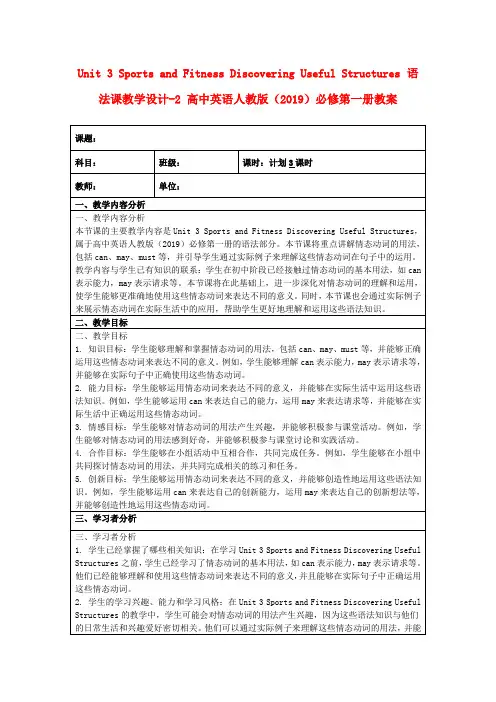
Unit 3 Sports and Fitness Discovering Useful Structures 语法课教学设计-2 高中英语人教版(2019)必修第一册教案课题:科目:班级:课时:计划3课时教师:单位:一、教学内容分析一、教学内容分析本节课的主要教学内容是Unit 3 Sports and Fitness Discovering Useful Structures,属于高中英语人教版(2019)必修第一册的语法部分。
本节课将重点讲解情态动词的用法,包括can、may、must等,并引导学生通过实际例子来理解这些情态动词在句子中的运用。
教学内容与学生已有知识的联系:学生在初中阶段已经接触过情态动词的基本用法,如can 表示能力,may表示请求等。
本节课将在此基础上,进一步深化对情态动词的理解和运用,使学生能够更准确地使用这些情态动词来表达不同的意义。
同时,本节课也会通过实际例子来展示情态动词在实际生活中的应用,帮助学生更好地理解和运用这些语法知识。
二、教学目标二、教学目标1. 知识目标:学生能够理解和掌握情态动词的用法,包括can、may、must等,并能够正确运用这些情态动词来表达不同的意义。
例如,学生能够理解can表示能力,may表示请求等,并能够在实际句子中正确使用这些情态动词。
2. 能力目标:学生能够运用情态动词来表达不同的意义,并能够在实际生活中运用这些语法知识。
例如,学生能够运用can来表达自己的能力,运用may来表达请求等,并能够在实际生活中正确运用这些情态动词。
3. 情感目标:学生能够对情态动词的用法产生兴趣,并能够积极参与课堂活动。
例如,学生能够对情态动词的用法感到好奇,并能够积极参与课堂讨论和实践活动。
4. 合作目标:学生能够在小组活动中互相合作,共同完成任务。
例如,学生能够在小组中共同探讨情态动词的用法,并共同完成相关的练习和任务。
5. 创新目标:学生能够运用情态动词来表达不同的意义,并能够创造性地运用这些语法知识。
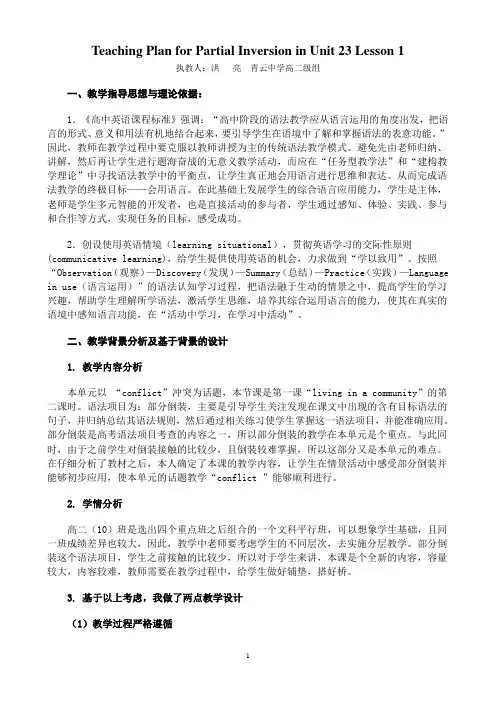
Teaching Plan for Partial Inversion in Unit 23 Lesson 1执教人:洪亮青云中学高二级组一、教学指导思想与理论依据:1.《高中英语课程标准》强调:“高中阶段的语法教学应从语言运用的角度出发,把语言的形式、意义和用法有机地结合起来,要引导学生在语境中了解和掌握语法的表意功能。
”因此,教师在教学过程中要克服以教师讲授为主的传统语法教学模式。
避免先由老师归纳、讲解,然后再让学生进行题海奋战的无意义教学活动,而应在“任务型教学法”和“建构教学理论”中寻找语法教学中的平衡点,让学生真正地会用语言进行思维和表达。
从而完成语法教学的终极目标——会用语言。
在此基础上发展学生的综合语言应用能力,学生是主体,老师是学生多元智能的开发者,也是直接活动的参与者,学生通过感知、体验、实践、参与和合作等方式,实现任务的目标,感受成功。
2.创设使用英语情境(learning situational),贯彻英语学习的交际性原则(communicative learning),给学生提供使用英语的机会,力求做到“学以致用”。
按照“Observation(观察)—Discovery(发现)—Summary(总结)—Practice(实践)—Language in use(语言运用)”的语法认知学习过程,把语法融于生动的情景之中,提高学生的学习兴趣,帮助学生理解所学语法,激活学生思维,培养其综合运用语言的能力, 使其在真实的语境中感知语言功能,在“活动中学习,在学习中活动”。
二、教学背景分析及基于背景的设计1. 教学内容分析本单元以“conflict”冲突为话题,本节课是第一课“living in a community”的第二课时。
语法项目为:部分倒装,主要是引导学生关注发现在课文中出现的含有目标语法的句子,并归纳总结其语法规则,然后通过相关练习使学生掌握这一语法项目,并能准确应用。
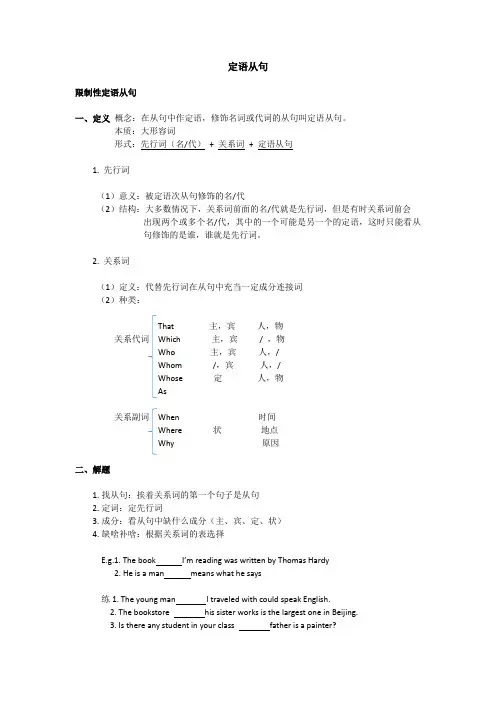
定语从句限制性定语从句一、定义概念:在从句中作定语,修饰名词或代词的从句叫定语从句。
本质:大形容词形式:先行词(名/代)+ 关系词+ 定语从句1. 先行词(1)意义:被定语次从句修饰的名/代(2)结构:大多数情况下,关系词前面的名/代就是先行词,但是有时关系词前会出现两个或多个名/代,其中的一个可能是另一个的定语,这时只能看从句修饰的是谁,谁就是先行词。
2. 关系词(1)定义:代替先行词在从句中充当一定成分连接词(2)种类:That 主,宾人,物关系代词Which 主,宾/ ,物Who 主,宾人,/Whom /,宾人,/Whose 定人,物As关系副词When 时间Where 状地点Why 原因二、解题1.找从句:挨着关系词的第一个句子是从句2.定词:定先行词3.成分:看从句中缺什么成分(主、宾、定、状)4.缺啥补啥:根据关系词的表选择E.g.1. The book I’m reading was written by Thomas Hardy2. He is a man means what he says练1. The young man I traveled with could speak English.2. The bookstore his sister works is the largest one in Beijing.3. Is there any student in your class father is a painter?介词+关系代词的用法介+ which(物)Whom(人)Whose介+which =where 介词有:at, in, from, on…=when 介词有:during, in, on, at…=why 介词有:forE.g. 1. This is the hero of we are proud2. The bookstore his sister works is the largest one in Beijing.3. Last month, part of Southeast Asia was struck by floods, from whose effects thepeople are still suffering.练I’d like you to explain the reason you were absent.结论:定语从句中,先行词表示时间、地点、原因,如果从句中谓语动词后接介词,关系词:关系代词如果从句谓语动词后没接介词,关系词:关系副词=介+which三、重叠先行词的区别that & which1. 只用That(1)当先行词是all、much、little、few、something、anything等不定代词时E.g. There is not much that ought to be done right now(2)当先行词被the only、the same、the very、the last等限定词修饰时E.g. Chatting was the only thing that interested her most.(3)当先行词是序数词、形容词最高级或先行词被该类词修饰时E.g. This is the best film that I have ever seen.(4)当主语以here、there开头时E.g. There is a seat in the corner that is still not occupied.(5)当主句是以who或which开头的特殊疑问句时E.g. Who is the person that is standing at the gate?(6)当先行词即有人又有物时E.g. She took photos of the things and people that she was interested in.(7)当先行词在主句中作表语,或者关系代词本身在从句中作标语时E.g. 1 He is not the man that he was.2 The school is quite different from the one that it used to be.2. 只用which(1)引导非限制性定语从句时(2)介词+which的情况that & who1. 只用that(1)当主语是以who开头的特殊疑问句时E.g. Who was the man that you danced with last night?(2)当先行词有the same修饰时E.g. He is the same person that killed that woman.(3)当先行词前有序数词,形容词最高级,the last,only修饰时E.g. He is the last man that I want to see.2.只用who(1)当先行词是person、people、those时E.g. Those who are for my for my plan, please put up your hands.(2)当先行词是one、any、all、he、they等时E.g. He who has not reached the Great Wall isn’t a true man.四、关系词的省略1. 关系代词的省略限制性定语从句中,关系代词作宾语或表语时可省略。
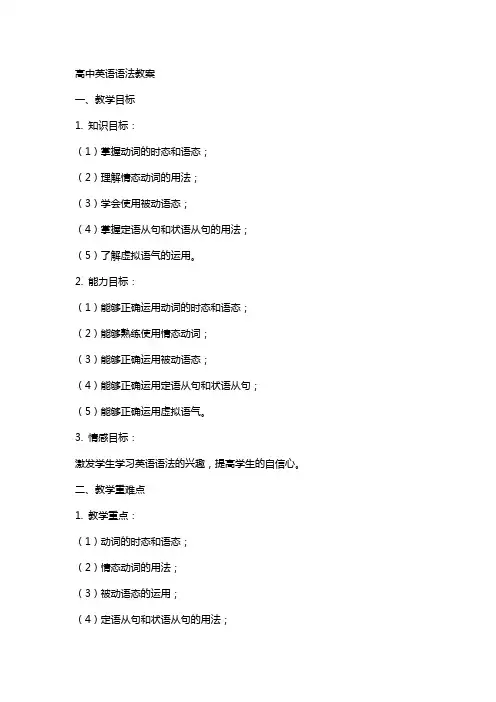
高中英语语法教案一、教学目标1. 知识目标:(1)掌握动词的时态和语态;(2)理解情态动词的用法;(3)学会使用被动语态;(4)掌握定语从句和状语从句的用法;(5)了解虚拟语气的运用。
2. 能力目标:(1)能够正确运用动词的时态和语态;(2)能够熟练使用情态动词;(3)能够正确运用被动语态;(4)能够正确运用定语从句和状语从句;(5)能够正确运用虚拟语气。
3. 情感目标:激发学生学习英语语法的兴趣,提高学生的自信心。
二、教学重难点1. 教学重点:(1)动词的时态和语态;(2)情态动词的用法;(3)被动语态的运用;(4)定语从句和状语从句的用法;(5)虚拟语气的运用。
2. 教学难点:(1)动词的语态变换;(2)定语从句和状语从句的引导词;(3)虚拟语气的特殊情境。
三、教学方法1. 情境教学法:通过设定各种真实的语境,让学生在实践中学习和掌握语法知识。
2. 任务型教学法:通过完成各种任务,激发学生的学习兴趣,培养学生的语法运用能力。
3. 合作学习法:引导学生相互讨论、交流,共同探讨语法问题,提高学生的团队协作能力。
四、教学准备1. 教材:高中英语教材;2. 课件:动词时态、语态、情态动词、被动语态、定语从句和状语从句、虚拟语气的课件;3. 练习题:相关语法练习题。
五、教学过程1. 导入:通过一个简单的英语小故事,引入本节课的主题。
2. 教学新课:(1)动词的时态和语态:讲解各种时态和语态的用法,并通过例句进行解释;(2)情态动词:介绍情态动词的用法,如can、may、must等;(3)被动语态:讲解被动语态的构成和用法;(4)定语从句和状语从句:介绍定语从句和状语从句的引导词及用法;(5)虚拟语气:讲解虚拟语气的特殊情境及用法。
3. 课堂练习:让学生完成一些相关的语法练习题,巩固所学知识。
4. 总结:对本节课的主要内容进行总结,强调重点和难点。
5. 课后作业:布置一些课后练习题,要求学生按时完成。
六、教学评估1. 课堂观察:观察学生在课堂上的参与程度、学习态度和语法运用情况。

高中英语语法教案(全套)及配套练习教案章节:一、动词时态教学目标:1. 理解动词时态的概念和重要性。
2. 掌握一般现在时、一般过去时、一般将来时、现在进行时、过去进行时、现在完成时和过去完成时的用法。
3. 能够正确运用动词时态进行句子构建和交流。
教学内容:1. 动词时态的概念和分类。
2. 一般现在时的用法,如:I like apples.3. 一般过去时的用法,如:I visited the museum yesterday.4. 一般将来时的用法,如:I will travel to Japan next year.5. 现在进行时的用法,如:I am reading a book now.6. 过去进行时的用法,如:She was watching TV yesterday evening.7. 现在完成时的用法,如:I have finished my homework.8. 过去完成时的用法,如:She had already eaten breakfast before I arrived. 教学活动:1. 引入动词时态的概念,让学生理解动词时态的重要性。
2. 通过例句和练习,讲解和巩固各个动词时态的用法。
3. 小组活动,让学生相互练习使用动词时态进行句子构建和交流。
配套练习:1. 选择题:判断下列句子中动词时态的使用是否正确。
2. 填空题:根据语境,选择合适的动词时态填空。
3. 翻译题:将下列句子翻译成英文,注意使用正确的动词时态。
教案章节:二、名词和冠词教学目标:1. 理解名词的概念和重要性。
2. 掌握可数名词和不可数名词的用法。
3. 掌握定冠词和不定冠词的用法。
4. 能够正确运用名词和冠词进行句子构建和交流。
教学内容:1. 名词的概念和分类。
2. 可数名词和不可数名词的用法,如:apple (可数名词)和water (不可数名词)。
3. 定冠词和不定冠词的用法,如:The cat (定冠词)和a cat (不定冠词)。

高中语法课教案【篇一:高中英语语法课教学设计】篇一:高中英语语法课教学活动的设计高中英语语法课教学活动的设计密云县第二中学季李红【摘要】本文结合三个课例,探讨了高中英语语法课教学活动设计可遵循的原则,以实现学生在课堂中的主体地位,发展思维能力,促进综合语言运用能力的形成。
【主题词】语法教学活动设计主体地位笔者以课例研究的方式对语法教学进行了大量实践,认为语法课教学活动的设计应注意以下原则。
一、教学活动的设计与教学目标一致教学活动的设计要与教学目标一致,为教学目标达成服务,因此每个教学活动要有明确的目的。
以北师大版第五模块第13单元语法项目---情态动词表推测,语言鲜活。
为了实现教学的第一个目标,笔者对教材设计的教学练习做了如下调推测的句子,没有足够调动学生的主动性,激发他们的思维活动;事实上,要学生关注目标语法结构前,教师应对语料进行必要的阅读理解处理,这有利于解决教学难点。
此外,文中有18个含情态动词的句子;其中4个不是情态动词表推测的句子。
若学生能将他们成功挑出,说明他们不但回顾了旧知识,理解了must, may, may not, might, can’t, could 表推测时,在上下文中表达的语气,而且更将注意力关注于目标语法。
本课的教学难点为:use the proper forms of modal verbs to express guesses about what happened and what is happening now. 为了在教学中突破难点,笔者将测的深层含义,同时又关注、归纳出了语法规则。
在归纳法语法教学模式中,学生首先接触的是包含语法规则的真实上下文情景,然后根据上下文的信息归纳出使用规则。
这种教学法有助于培养学生的语感。
通过分析归纳总结语言使用规律课深化学生对用法的理解,培养学生的逻辑思维能力。
但教师必须提供充足的,以语境为依托的语料,教学活动的形式适合学生的认知水平,他们的观察、体验、探究、合作等主动学习行为才得以开展。
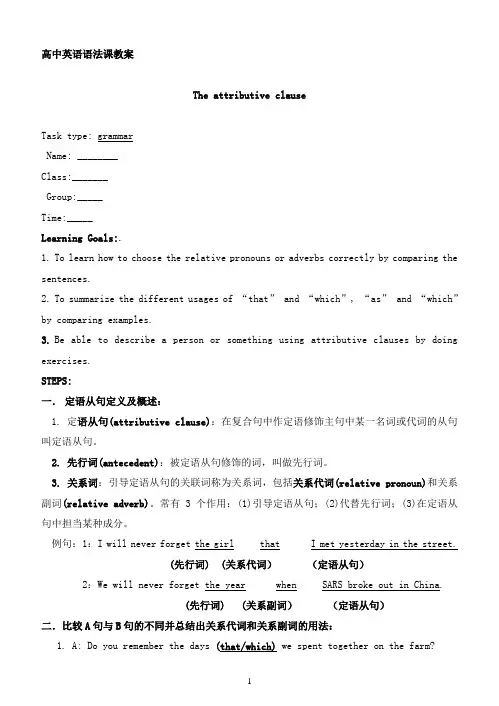
高中英语语法课教案The attributive clauseTask type: grammarName: ________Class:_______Group:_____Time:_____Learning Goals:.1.To learn how to choose the relative pronouns or adverbs correctly by comparing the sentences.2.To summarize the different usages of “that” and “which”, “as” and “which”by comparing examples.3.Be able to describe a person or something using attributive clauses by doing exercises.STEPS:一.定语从句定义及概述:1. 定语从句(attributive clause):在复合句中作定语修饰主句中某一名词或代词的从句叫定语从句。
2. 先行词(antecedent):被定语从句修饰的词,叫做先行词。
3. 关系词:引导定语从句的关联词称为关系词,包括关系代词(relative pronoun)和关系副词(relative adverb)。
常有 3个作用:(1)引导定语从句;(2)代替先行词;(3)在定语从句中担当某种成分。
例句:1:I will never forget the girl that I met yesterday in the street.(先行词) (关系代词)(定语从句)2:We will never forget the year when SARS broke out in China.(先行词) (关系副词)(定语从句)二.比较A句与B句的不同并总结出关系代词和关系副词的用法:1. A: Do you remember the days (that/which) we spent together on the farm?B: Do you remember the days when we chatted with each other all night?2.A: The hotel that/which is different from others is designed by a famous designer. B: The hotel where we stayed was very clean.3. A: This is the reason (that/which) he explained.B: This is the reason why I did it.4. Rose is the person whom you should look after.5. I know the person whose company produces computers.6. He was late again, which made his headmaster angry.7. As we all know, China has become a world famous nation.总结:1:当定语从句句子成分不完整,缺少主语、宾语、表语或定语时,我们选择____________,包括:____________________________。
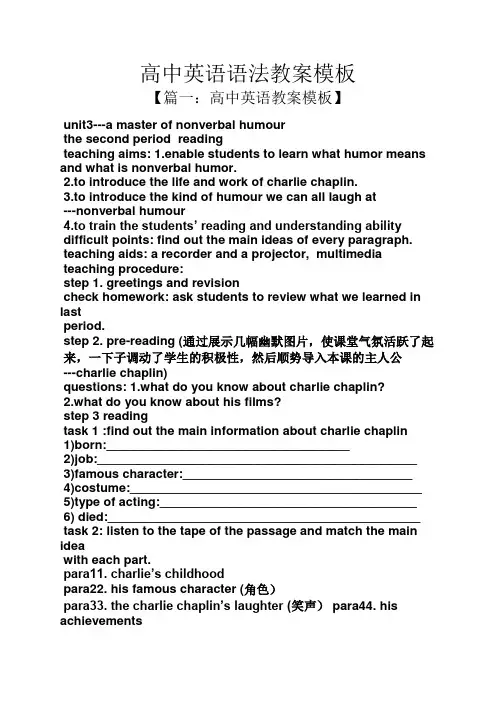
高中英语语法教案模板【篇一:高中英语教案模板】unit3---a master of nonverbal humourthe second period readingteaching aims: 1.enable students to learn what humor means and what is nonverbal humor.2.to introduce the life and work of charlie chaplin.3.to introduce the kind of humour we can all laugh at---nonverbal humour4.to train the students’ reading and understanding abilitydifficult points: find out the main ideas of every paragraph.teaching aids: a recorder and a projector, multimediateaching procedure:step 1. greetings and revisioncheck homework: ask students to review what we learned in lastperiod.step 2. pre-reading (通过展示几幅幽默图片,使课堂气氛活跃了起来,一下子调动了学生的积极性,然后顺势导入本课的主人公---charlie chaplin)questions: 1.what do you know about charlie chaplin?2.what do you know about his films?step 3 readingtask 1 :find out the main information about charlie chaplin1)born:___________________________________2)job:______________________________________________3)famous character:_________________________________4)costume:__________________________________________5)type of acting:_____________________________________6) died:_____________________________________________ task 2: listen to the tape of the passage and match the main ideawith each part.para11. charlie’s childhoodpara22. his famous character (角色)para33. the charlie chaplin’s laughter (笑声) para44. his achievementspara55. an example of his worktask 3: answer the following questions:1. what’s the passage mainly about?a. the history of english humour?b. the films chaplin made.c. the humour chaplin made in his films.d. the gold rush in alaska.2. when and where is the film the gold rush set in?a. it is set in california at the end of the nineteenth century.b. it is set in canada at the end of the nineteenth centuryc. it is set in alaska in the middle of the nineteenth centuryd. it is set in canada in the middle of the nineteenth century3. charlie chaplin made people laugh when they felt depressed, so they could feel____________a. less content with their livesb. more satisfied with their livesc. more worried about their livesd. they had a miserable lifetask 4: give a description on little tramp.the little tramp, a poor, homeless man with a moustache, wore asmall round black hat, large trousers and worn-out shoes carrying a walking stick.task 5: introduce the main films of charlie chaplin.the gold rush , modern times, the great dictator...-- enjoy the part of the film ---the gold rush(利用多媒体播放卓别林的经典影片the gold rush中的片段,让学生体会以下大师的惟妙惟肖的表演,从而激发学生的好奇心,使其迫不及待地去读课文,更深入地了解“无声的幽默的大师—卓别林”.) task 6: after seeing the film, find the correct order of the following events.chaplin tried cutting and eating the bottom of the shoe.chaplin and his friend washed sand and expected to pick up gold,but they failed.they were so hungry that they boiled a pair of leather shoes.they were caught in a small wooden house.chaplin cut off the leather top of the shoe.chaplin picked out the laces of the shoe.step 4: post-readinganswer the questions: 1.besides joy, what else can humor bring to us in our studies and life?( relaxation, confidence, hope, joy, health, friendship, love...)2. the reasons for his success:( determination, devotion, optimistic attitude to life, kindness sympathy to the poor... )3. give students a humorous story if time permitting.step 5: conclusiontoday we have learned something about humor, it is everywhere in our daily life. i hope you can be optimistic(乐观的) no matter what difficulties you meet with, just as charlie chaplin was.step 6: homework1.write a humorous story in english and find out the grammar items in this passage.2.pre-view the important words and expressions in the text.【篇二:高中英语复习教案模板】unit 1 women of achievement (教案设计)Ⅰ. teaching basis (教学依据) :《普通高中英语新课程标准》Ⅱ. the type of the text (课型) :revision (复习课)Ⅲ. teaching methods(教学方法): question-based method(提问式),group discussionmethod(小组讨论法),cooperative learning(合作探究),practicing(练习).Ⅳ. teaching aids (教学手段) :multimedia computer(多媒体电脑),learningpaper(导学案),blackboard(黑板).Ⅴ. teaching aims(教学目标) :①knowledge aims(知识目标):words: achievement, specialist, organization, hard-working, confident….. phrases: put to death, mean doing, either…or…, the bond between……, structure: only+…., itis/was+….+that…. grammar: subject-verb agreement.②ability aims(能力目标): develop the stu dents’ ability to use the importantlanguage points, enable students to describe people using the adjectives.③emotional aims(情感目标): encourage the students to think about what makes aperson great.Ⅵ. teaching focuses(教学重点):get the students to review and consolidate what theyhave learned in this unit.Ⅶ. teaching difficulties(教学难点):get the students to turn what they have learned intotheir ability.Ⅷ.teaching procedure(教学过程): step 1 复习学案情况反馈(1分钟)step 2 lead-in :通过图片展示的方式,过渡到知识竞答类节目《一站到底》,本节课也将模仿这种模式授课。
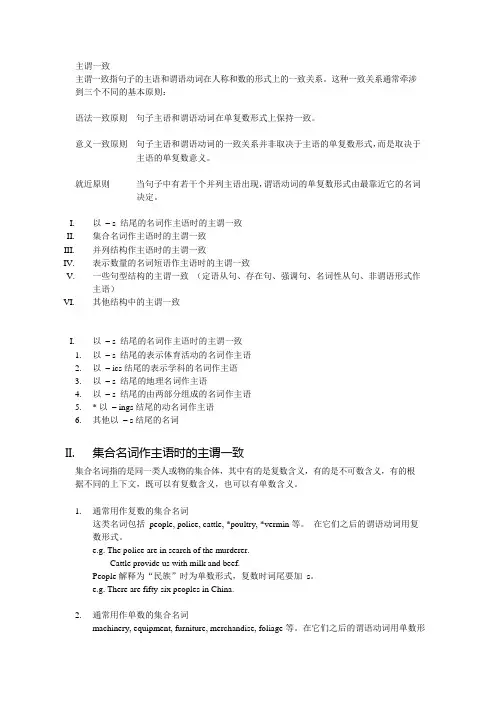
主谓一致主谓一致指句子的主语和谓语动词在人称和数的形式上的一致关系。
这种一致关系通常牵涉到三个不同的基本原则:语法一致原则句子主语和谓语动词在单复数形式上保持一致。
意义一致原则句子主语和谓语动词的一致关系并非取决于主语的单复数形式,而是取决于主语的单复数意义。
就近原则当句子中有若干个并列主语出现,谓语动词的单复数形式由最靠近它的名词决定。
I.以– s 结尾的名词作主语时的主谓一致II.集合名词作主语时的主谓一致III.并列结构作主语时的主谓一致IV.表示数量的名词短语作主语时的主谓一致V.一些句型结构的主谓一致(定语从句、存在句、强调句、名词性从句、非谓语形式作主语)VI.其他结构中的主谓一致I.以– s 结尾的名词作主语时的主谓一致1.以– s 结尾的表示体育活动的名词作主语2.以– ics 结尾的表示学科的名词作主语3.以– s 结尾的地理名词作主语4.以– s 结尾的由两部分组成的名词作主语5.* 以– ings 结尾的动名词作主语6.其他以– s 结尾的名词II.集合名词作主语时的主谓一致集合名词指的是同一类人或物的集合体,其中有的是复数含义,有的是不可数含义,有的根据不同的上下文,既可以有复数含义,也可以有单数含义。
1.通常用作复数的集合名词这类名词包括people, police, cattle, *poultry, *vermin 等。
在它们之后的谓语动词用复数形式。
e.g. The police are in search of the murderer.Cattle provide us with milk and beef.People 解释为“民族”时为单数形式,复数时词尾要加s。
e.g. There are fifty-six peoples in China.2.通常用作单数的集合名词machinery, equipment, furniture, merchandise, foliage 等。
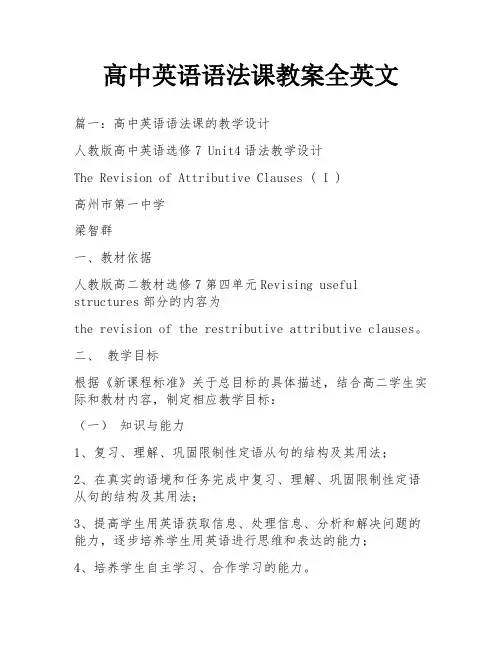
高中英语语法课教案全英文篇一:高中英语语法课的教学设计人教版高中英语选修7 Unit4语法教学设计The Revision of Attributive Clauses ( I )高州市第一中学梁智群一、教材依据人教版高二教材选修7第四单元Revising useful structures部分的内容为the revision of the restributive attributive clauses。
二、教学目标根据《新课程标准》关于总目标的具体描述,结合高二学生实际和教材内容,制定相应教学目标:(一)知识与能力1、复习、理解、巩固限制性定语从句的结构及其用法;2、在真实的语境和任务完成中复习、理解、巩固限制性定语从句的结构及其用法;3、提高学生用英语获取信息、处理信息、分析和解决问题的能力,逐步培养学生用英语进行思维和表达的能力;4、培养学生自主学习、合作学习的能力。
(二)过程与方法1、采用“任务型”语言教学。
根据不同的语法内容设计不同的任务,让学生通过完成任务,在语言运用中去学习、掌握语言形式和语言规则,使学生在做中学,在做中练,在做中巩固。
2、利用真实的环境或设计模拟的情境进行语法教学,使语法教学更趋形象化、直观化、真实化和趣味化。
情景活动中的学习降低了语法学习的难度,激发了学生学习英语的积极性,使他们学得快,记得牢,用得活。
3、把某些语法教学转化为交际活动,具体设计有:(1)英文歌式通过画出英文歌中的restributive attributive clauses,使教学内容生动形象,不仅调动学生的学习兴趣,而且营造良好的课堂氛围。
(2)游戏式根据教学内容设计“接龙”游戏及猜谜游戏。
在这样的操练活动中,学生既锻炼了思维能力与快速反应能力,又加深了对所学语法现象的理解,同时使语法教学既轻松又有效。
(3)讨论式设计一些练习,让学生与同桌或小组同学相互讨论学习,激发学生学习的兴趣,增强学生对英语语言信息的使用和接受能力。
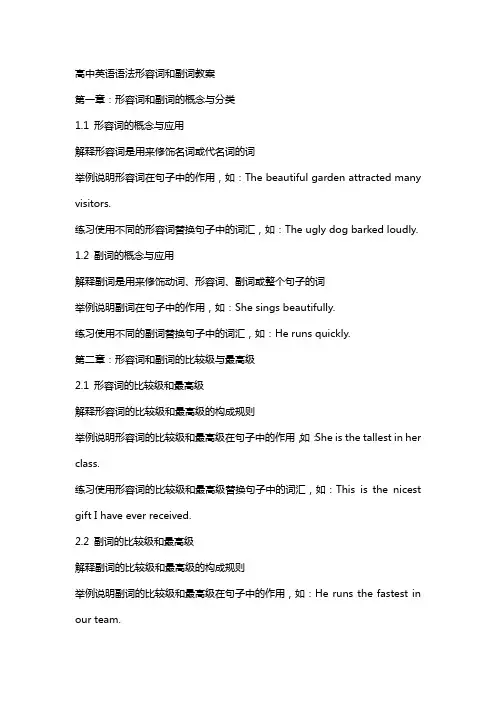
高中英语语法形容词和副词教案第一章:形容词和副词的概念与分类1.1 形容词的概念与应用解释形容词是用来修饰名词或代名词的词举例说明形容词在句子中的作用,如:The beautiful garden attracted many visitors.练习使用不同的形容词替换句子中的词汇,如:The ugly dog barked loudly.1.2 副词的概念与应用解释副词是用来修饰动词、形容词、副词或整个句子的词举例说明副词在句子中的作用,如:She sings beautifully.练习使用不同的副词替换句子中的词汇,如:He runs quickly.第二章:形容词和副词的比较级与最高级2.1 形容词的比较级和最高级解释形容词的比较级和最高级的构成规则举例说明形容词的比较级和最高级在句子中的作用,如:She is the tallest in her class.练习使用形容词的比较级和最高级替换句子中的词汇,如:This is the nicest gift I have ever received.2.2 副词的比较级和最高级解释副词的比较级和最高级的构成规则举例说明副词的比较级和最高级在句子中的作用,如:He runs the fastest in our team.练习使用副词的比较级和最高级替换句子中的词汇,如:She speaks more clearly than her classmates.第三章:形容词和副词的短语搭配3.1 形容词短语搭配解释形容词短语搭配的概念,如:感到兴奋、变得疲惫举例说明形容词短语搭配在句子中的作用,如:I was excited to receive the scholarship.练习使用不同的形容词短语搭配替换句子中的词汇,如:She felt tired after the long walk.3.2 副词短语搭配解释副词短语搭配的概念,如:非常、极其举例说明副词短语搭配在句子中的作用,如:She sings extremely well.练习使用不同的副词短语搭配替换句子中的词汇,如:He runs very fast.第四章:形容词和副词在句子中的位置4.1 形容词在句子中的位置解释形容词在句子中的常见位置,如:前置、后置举例说明形容词在句子中的不同位置,如:The red car is fast.练习将形容词放在不同位置,如:Fast is the red car.4.2 副词在句子中的位置解释副词在句子中的常见位置,如:前置、后置、修饰动词、形容词等举例说明副词在句子中的不同位置,如:She sings beautifully.练习将副词放在不同位置,如:Beautifully she sings.5.1 形容词和副词的选择与运用提供多个句子,要求学生根据句意选择合适的形容词和副词练习使用形容词和副词替换句子中的词汇,如:The sun is____(high/low) in the sky.5.2 形容词和副词的填空练习提供填空题,要求学生根据句意填入合适的形容词和副词练习使用形容词和副词填空,如:She____(run/runs) faster than her brother.5.3 形容词和副词的写作练习提供写作题目,要求学生使用形容词和副词描述人物、物体或场景练习使用形容词和副词进行写作,如:描述你最难忘的一次旅行经历。
高中英语语法教案-动词不定式动词不定式由to+动词原形构成。
这里的to是不定式标志,没有词义。
不定式具有名词、形容词或副词的某些语法功能,又有动词的时态和语态的特点及作用。
常见的形式如表所示(以及物动词do为例),不及物动词没有被动语态。
时态\\语态主动被动一般式to do to be done进行式to be doing /完成式to have done to have been done完成进行式to have been doing /1 有些动词可以用不定式作宾语,大致上有三种情况。
1) 有些及物动词用不定式作宾语,结构为动词+不定式。
例如:afford aim agree arrange ask decidebother care choose demand desire determineelect endeavor hope fail help learnlong 渴望mean manage offer plan pretendrefuse tend undertake expect hate intend例如:The driver failed to see the other car in time. 司机没能及时看见另一辆车。
He offered to help me. 他表示愿意帮助我。
2)有些动词除了可以用不定式作宾语,还用不定式作补语,即有动词+宾语+不定式的结构。
例如:ask choose expect help beg intendlike/love need prefer prepare want wish例如:I like to keep everything tidy. 我喜欢每件东西都保持整洁。
I like you to keep everything tidy. 我喜欢你使每件东西都保持整洁。
I want to speak to Tom. 我想和汤姆谈话。
I want you to speak to Tom. 我想让你和汤姆谈话。
高中英语语法教案名词标题:高中英语语法教案——名词一、教学目标1、让学生掌握名词的定义和分类。
2、让学生掌握名词的数、性以及在句子中的用法。
3、通过练习和活动,使学生能够熟练运用名词。
二、教学内容1、名词的定义和分类2、名词的数、性以及在句子中的用法3、名词的特殊用法和注意事项三、教学方法1、通过讲解和示范,使学生了解名词的基本概念和分类。
2、通过练习和活动,使学生掌握名词的数、性以及在句子中的用法。
3、通过课堂讨论和小组活动,使学生理解并掌握名词的特殊用法和注意事项。
四、教学步骤1、导入新课:让学生回答一些包含名词的简单问题,引导学生思考名词在语言中的作用。
2、讲解名词的定义和分类:通过例子和图示,使学生理解名词的定义和分类。
3、练习名词的数、性以及在句子中的用法:通过填空、改错等练习,使学生掌握名词的数、性以及在句子中的用法。
4、讲解名词的特殊用法和注意事项:通过例子和讲解,使学生了解名词的特殊用法和注意事项。
5、小组活动:让学生分组讨论一些名词的用法和注意事项,并在课堂上进行交流和分享。
6、课堂小结:回顾本节课的重点内容和知识点,强调名词的重要性,鼓励学生在语言实践中多加运用。
7、布置作业:布置一些与名词相关的练习题和阅读材料,以巩固和拓展学生的知识和能力。
五、教学评估1、通过课堂练习和小组活动,评估学生对名词的掌握程度。
2、通过课后作业和考试,评估学生对名词的运用能力。
3、通过学生自评和互评,了解学生对名词的学习体验和感受。
六、教学反思1、反思教学方法的有效性,是否能够达到教学目标。
2、反思教学过程中的优点和不足,如何改进和提高教学质量。
3、反思学生的学习状态和反馈,如何更好地满足学生的学习需求。
总之,通过本次教案的实施,我们希望能够让学生更好地掌握英语语法中的名词,为他们的英语学习和语言实践打下坚实的基础。
我们也需要在反思和改进中不断提高教学质量,为学生提供更好的学习体验和服务。
高中英语语法名词本文将为大家详细介绍高中英语语法中的一些重要名词,包括句子结构、主语、谓语、宾语、定语、状语等。
《高中英语(上外版)》必修第三册Unit 1 Road to Success课时:第3课时课题:Grammar in Use课型:语法课教学设计与说明一.学情分析本节课授课对象为高一第二学期的学生。
经过第一学期的学习,同学们已经有了分词在句子中各项功能的总体概念。
但是大部分同学们对分词各项句法功能的总体框架结构是不清晰的,对分词的各项句法功能各自的特点、重点、难点没有概念。
所以需要帮助学生分项理清特点、重点、难点,并在语言实际交际运用中加以操练并巩固。
二.教材分析单元语法运用Grammar in Use聚焦于分词作补语(宾语补足语和主语补足语)的复习和巩固。
教材P9-10上有三道语法练习题。
第一题旨在分析分词在句子中的功能,认识分词做补语的结构。
第二题旨在辨认分词作补语的结构并能正确区分这一结构中现在分词和过去分词在做补语时的区别。
第三题考查语言的综合运用能力,要求学生在语篇中、在上下文语境中理解、分析、归纳并灵活运用分词作补语这一语法功能,同时要求学生区分分词作补语与分词其它功能的区别。
三.教学设计思路本课为本单元语法教学的第二课时:语法练习课,旨在帮助学生在第一节语法课的基础上复习巩固分词作补语这一语法功能,并为学生创设产出的机会,提高语用能力。
导入部分利用课本P8-9练习I&II,采用归纳演绎教学法复习第一课时学习过的内容,引导学生学会对学过的语法规则进行分类归纳,在头脑中形成非谓语知识体系的网络架构。
操练部分采用任务型教学方法,在遵循学生认知规律的基础上设置多层次能力要求逐步递进的实践任务,引导学生在完成各个层次的任务中逐步实现分词做补语这一语法功能的内化,并在任务中实现learning by using, learning for using的语法学习目标。
Lesson Plan(the 3 period)rdLearning Objectives:By the end of the period, the students are expected to:1. have the ability of classifying and summarizing grammar rules of -ing / -ed forms as complements;2. form the network of -ing / -ed forms as complements in mind so as to distinguish them from other functions of -ing / -ed forms;3. skillfully apply -ing / -ed forms as complements in listening, reading and writing.Learning Procedures:Step I. Revision (Interactive activity)*T: Help the students recall and classify what they learned in the first period of Grammar in Use with the help of Exercise I & II on P 8-9.*Ss: Recall the grammatical rules of -ing / -ed forms used as complements by category.I. -ing form used as complements:feel / hear / listen to / see / watch / look at / notice / observe ... + O. + doing (O. C.)S.+ be felt / heard ... + doing (S. C.)discover / find / smell / catch ... + O. doing (O. C.)S. + be + discovered ... + doing (S. C.)get / have / keep / leave / send / set / start ... + O. doing (O. C.)with + O. + doing (O. C.)II. -ed form used as complements:see / hear / watch / find / feel / consider ...+ O. + done (O. C.)S.+ be seen ... + done (S. C.)get / have / keep / leave / make ... + O. + done (O. C.)declare / like / need / order / want / wish ... + O. + done (O. C.)with + O. + done (O. C.)Note: After working non-stop for twenty hours, he went to bed tired and hungry. (O. C.) The athlete went away quite satisfied with the result of the match. (O.C.)Step II. PracticeI. Identify - ing /- ed forms as complements in the lyrics (Task 1)*T: Play the song “Those Sweet Words” and ask students to identify - ing /- ed forms as complements in the lyrics while enjoying the melody. And then focus on the functions of -ing / -ed forms in “Iknow I saw you saying it.” and “I just h ave to hear t hose sweet words s poken like a melody.” and the meanings of the two sentences.*Ss: Identify - ing /- ed forms as complements and translate the two sentences into Chinese.Those Sweet WordsBy Norah JonesWhat did you sayI know I saw you saying itMy ears won't stop ringingLong enough to hearThose sweet wordsWhat did you sayAnd now the dayThe hour hand has spunBefore the night is doneI just have to hearThose sweet wordsSpoken like a melodyAll your love...II. Apply -ing / -ed forms as complements in individual sentences. (Task 2)*T: Ask students to identify the structure of -ing / -ed forms as complements in the following sentences and then fill in the blanks with proper forms of the verbs given in the box. Call students’attention to the differences between -ing forms as complements and -ed forms as complements.*S: Read the sentences silently and underline the structure of -ing / -ed forms as complements in each sentence and then fill in the blanks with -ing forms or -ed forms based on grammar rules of the differences between -ing forms as complements and -ed forms as complements.III. Apply -ing / -ed forms as complements in a passage. (Task 3)*T: Ask students to read a short passage and fill in the blanks with the -ing / -ed forms of the verbs given in the box. Then circle the ones that are used as complements. Call students’ attention to the differences between -ing / -ed forms as complements and -ing / -ed forms for other functions.*S: Read the short passage silently and circle the structures of -ing / -ed forms as complements in the passage and then fill in the blanks with -ing forms or -ed forms based on grammar rules of the differences between -ing / -ed forms as complements and -ing / -ed forms for other functions.IV. Apply -ing / -ed forms as complements in writing sentences. (Task 4)*T: Ask students to read each sentence in Chinese carefully and make out which category of -ing / -ed forms as complements fits the contexts best based on the given word in the brackets. And then translate the whole sentence into English.*S: First, make out and write down the proper structure of -ing / -ed forms as complements. Then, translate the whole sentence into English.。
一、教学目标1. 让学生理解定语从句的概念和作用。
2. 让学生掌握定语从句的引导词及其用法。
3. 让学生能够正确运用定语从句修饰名词或代词。
4. 提高学生的英语写作和口语表达能力。
二、教学内容1. 定语从句的定义和作用2. 定语从句的引导词:who, which, that, where, when, why3. 定语从句的先行词:名词、代词、并列名词4. 定语从句的省略现象5. 定语从句的句子结构三、教学过程1. 引入:通过展示一些含有定语从句的句子,让学生感受定语从句的存在,并引导学生思考定语从句的作用。
2. 讲解:详细讲解定语从句的定义、作用、引导词及用法,通过例句进行说明。
3. 练习:让学生分组练习,用所学的定语从句知识修改或创作一些句子。
4. 拓展:引导学生思考定语从句在实际生活中的应用,如购物、描述物品等。
四、练习题1. 选出正确的定语从句引导词:a. 我有一个()朋友,他很有趣。
b. 她在一家()公司工作。
c. 我喜欢那个()演奏钢琴的音乐家。
d. 这本书的()部分我已经读过了。
2. 完成定语从句的练习:a. 我的兄弟是一个()工程师,他在一家大型企业工作。
b. 昨天我遇到了一个()很久没见的老朋友。
c. 那个()去年去了美国的女孩现在回来了。
d. 我听说()在这个小区开了一家新餐馆。
3. 判断下列句子是否正确,并解释原因:a. 我昨天遇到了一个多年不见的老朋友。
b. 我昨天遇到了一个多年不见的多年不见的老朋友。
c. 我昨天遇到了一个多年不见的老朋友多年不见的人。
五、教学评价1. 课后作业:要求学生运用所学知识,编写一段含有定语从句的文字。
2. 课堂练习:观察学生在课堂练习中的表现,了解他们对定语从句的掌握程度。
3. 学生互评:让学生互相评价对方的作业,提高他们的语言表达能力。
4. 教师评价:对学生的作业进行评价,给予鼓励和指导。
六、教学策略1. 实例教学:通过展示各种类型的定语从句实例,让学生直观地理解定语从句的用法。
高中英语语法形容词和副词教案一、教学目标1. 让学生掌握形容词和副词的基本概念及其用法。
2. 培养学生正确运用形容词和副词修饰名词和动词的能力。
3. 提高学生英语写作和口语表达的准确性和丰富性。
二、教学内容1. 形容词和副词的定义及其作用。
2. 形容词和副词的词性和变化。
3. 形容词和副词的比较级和最高级。
4. 形容词和副词的常见搭配。
5. 形容词和副词在句子中的位置和用法。
三、教学重点与难点1. 形容词和副词的词性和变化。
2. 形容词和副词的比较级和最高级。
3. 形容词和副词的常见搭配。
4. 形容词和副词在句子中的位置和用法。
四、教学方法1. 采用情境教学法,通过实物、图片、例句等方式引导学生理解形容词和副词的用法。
2. 运用任务型教学法,让学生在实际操作中练习运用形容词和副词。
3. 采用分组讨论法,鼓励学生相互交流、合作,提高语言实践能力。
五、教学步骤1. 导入:通过展示图片或实物,引导学生说出相关的形容词和副词,引出本课主题。
2. 讲解:讲解形容词和副词的定义、词性、变化、搭配及在句子中的位置和用法。
3. 练习:设计不同类型的练习题,让学生巩固所学知识。
4. 拓展:介绍形容词和副词的常见搭配,并举例说明。
6. 作业:布置相关的练习题,让学生课后巩固。
六、教学活动1. 设计形容词和副词的寻找游戏,让学生在图片或句子中找出形容词和副词。
2. 进行小组竞赛,看哪个小组能正确使用形容词和副词完成句子。
3. 角色扮演:学生分组扮演不同角色,使用形容词和副词描述角色特征或环境。
七、课堂互动1. 提问:让学生回答关于形容词和副词的问题,如定义、用法等。
2. 讨论:分组讨论形容词和副词的搭配,分享彼此的发现。
3. 问答:学生相互提问,用形容词和副词描述对方的特点。
八、课堂实践1. 写作练习:让学生写一篇短文,用形容词和副词描述一个事物或人物。
2. 口语表达:让学生用形容词和副词描述自己的日常生活或经历。
3. 听力练习:播放含有形容词和副词的对话或短文,让学生回答相关问题。
高中英语语法教案(5篇)高中英语语法教案篇一一、教材分析(一)教材的地位和作用本节课是本单元以及本教材的第一节课,本课谈论的是:朋友是不是仅限于人类、朋友的真正含义、如何与人相处的问题等关于朋友的话题。
本课涉及的有陈述句和疑问句的直接引语和间接引语的掌握和运用等语法要点。
学生从初中到高中,来到一个新的学校,同学彼此陌生,不免想起老同学,老朋友。
这样的话题正好能引起学生的兴趣。
而且本课的内容和语法的启发性和实用性都很强,能使学生在学中用,在用中学,对综合提高学生的听说读写能力有较好的促进作用。
(二)教学目标英语教学大纲规定,通过听说读写的训练,使学生获得英语基础知识和运用英语的能力,激发学生的学习兴趣,为进一步学习打下良好的基础。
因此,我制定以下教学目标:知识目标:1、掌握和使用陈述句和疑问句的直接引语和间接引语。
2、讨论朋友和友谊。
3、学习掌握本课的重点词汇。
技能目标:1、学会阅读的技能——scanningand skimming 。
2、通过谈论朋友和友谊,既锻炼学生的语言运用能力,又培养了学生发现问题、思考问题、解决问题的能力。
3、理解阅读文段,复述故事。
情感态度:1、患难之交才是真朋友。
2、知音难得。
3、海内存知己,天涯若比邻。
文化意识:认识德国的纳粹党。
让学生了解那段德国法西斯残害犹太人的历史,使学生在感受外国历史文化的同时自然而然的习得语言。
(三)重点与难点重点:1、训练scanningand skimming等阅读技能。
2、认识朋友的真正含义以及与人相处的问题。
难点:1、阅读技能的训练。
2、陈述句和疑问句的直接引语和间接引语的互相转换(人称的变化、时态的变化、指示代词、时间状语、地点状语和动词的变化)。
(四)教具本课利用录音机、投影仪等辅助设备,激发学生的学习兴趣,调动他们的积极性,为展开话题提供丰富的材料,使教学收到事半功倍的效果。
二、教法分析在新课程背景下,教师要成为学生学习的促进者、组织者和合作者。
高中英语语法“虚拟语气”的教学设计一、教材分析:本课是结合外研社版高中英语教材选修 6 中有关虚拟语气的语法内容,进行高三虚拟语气的复习,教学中将语法知识的传授和语言基本技能的学习结合到一起,注重复习语法与语言的运用。
采用任务型教学法和小组合作探究学习法,从而扩大课堂的语言输入量及学生的语言输出量。
二、学情分析:在高一和高二英语学习基础上,高三学生已经掌握基本的语言结构和一定程度的听说读写能力。
在高三语法复习的过程中,结合学生原有的知识掌握水平,巩固基础强化正确使用语法知识,提高学生运用语言的深度和难度. 但大部分学生的基础知识仍然较为薄弱,运用英语进行交际活动的能力较差,主动学习的动力不够,然而他们学习比较认真,渴求知欲旺盛,思维比较活跃。
部分学生的基础较好,能主动配合老师。
只有设置使他们感兴趣的活动,因材施教,才能让他们投入到课堂活动中来。
三、教学重点 :1.复习的重点 --- 语法虚拟语气的句型结构 .2.语法虚拟语气的运用四、教学难点 :1.结合复习的语法知识,以课堂教学为依托,全面训练学生的听、说、读、写能力,加强和提高运用英语的综合能力。
2.虚拟语气在真实的生活语境中的使用。
五、教学目标 :1.知识目标 :引导学生掌握情态动词在虚拟语气之中的使用。
培养学生通读,分析,理解,综合的能力,教会学生体察语境,结合上下文,附和逻辑推理和合理的想象,结合语法和题干中的语境解决高考题。
在运用语言过程中培养学生的观察力、分析力、想象力和自学能力,提高思维能力和运用英语的综合能力。
2.能力目标:利用多媒体手段营造积极和谐教学氛围,使学生进入情景之中,充分调动学生的思维活动和情感体验,规范学生运用英语知识准确表达的能力,同时,发展学生综合语言运用的能力,分析问题和解决问题的能力,培养学生自主学习。
3.德育目标:用情态动词和虚拟语气的句子结构表达思想感情和正确的世界观、人生观。
六、教学策略 :通过活动课、小组讨论等具体形式,创设有利于高中生自己自我认识、自我反省、自我调节的情境,利用他们自身较高的自我意识水平对自己的学习进行调节、监控。
因此,本课采用教学方法 --- 任务型教学法。
以任务为中心,任务的设计焦点是解决某一具体的贴近学生生活的问题。
教师要从学生“学”的角度来设计教学活动,使学生的学习活动具有明确的目标。
在的各种“任务”中,学生能够不断地获得知识并得出结论。
七、学习策略 :非测试性评价体现新课程标准的实施效果,评价体系“正确反映外语学习的本质和过程,满足学生发展的需要。
”本课将各种活动设计成小组活动并开展小组竞赛和填写课堂自我评价表等非测试性评价手段,帮助学生养成自主学习与合作学习的能力,培养创新意识和实践能力,以及具备科学的价值观。
八、教学用具:黑板、录音机、多媒体辅助(将本课所需要的图片、文字、音乐等制成 PPT 课件)九、教学过程Step1 Warming up (5 minutes )Discuss about the pictures together , andlost express their ideas freely . Such as, What would you do now, if youyour vision or other valuable things ? You wish设计说明:1.教师首先展示美国聋哑女作家海伦·凯勒的影片图片和主要作品,然后请学生阅读以下片段:假如给我三天光明(节选)请学生思考一下这个问题:假如你只有三天的光明,你会怎么做?教师通过多媒体呈现图片,目的吸引学生的注意力,并激发起好奇心。
2.利用新颖和形象的图片导入,有利于学生参与教学活动,进行讨论和对话活动。
帮助学生学会珍惜拥有,学会生活。
Hold an English poem recital competition.Task1: Divide the whole class into a number of groups. Each group asks one student to act as the competitor with musicLiving life overIf I had my life live over I would have talked less and listened moreI would have invited my friend over to dinner even if the carpetwas strained and the sofa fadedTask2:Choose the best group that read the poem with their deepestfeeling.评价工具(选票):选出朗读最好的学生。
设计说明:1.用配乐英文诗歌朗诵的方式导入语法 --- 虚拟语气的学习。
该诗歌几乎每句都使用虚拟语气来表达思想,传递情感。
2.任务型活动:课题的引入采用诗歌朗诵竞赛的形式,学生小组活动,对英文诗歌进行翻译,激发参与学习过程的热情和竞争意识。
最后由全体同学对各组参与代表投票进行非测试性评价。
Step3 Revision(7 minutes)Firstly ,ask the students to answer the questions in groups to summarize the basic structure of the grammar.1.If there _______ (be) no computer, the students _______(learn)much now.2. If there _______ (not be) the war, people ______(live) a happier life in the future.3. If you ________ (come) yesterday, you _______ (see) Jackie Chen.4. If you______ (attend) the concert, your oral English_______(become) better now.设计说明:1. 教师在进行语法教学的过程中把握好教学内容和教学范围的度,适应高三复习的需要,加强语法教学的交际性,科学性和可操作性。
2.合作学习活动,学生在活动中运用语言,调动起学生的认知结构和主体意识。
教师把语法规则活化为活动,把教学活动活化为交际活动。
设分组竞答游戏活动,激发学生的参与意识。
Step4 Consolidation (5minutes)1. If Newton lived today, he would be surprised by what ______ inscience and technology.A. had discoveredB. had been discoveredC. has discoveredD. has been discovered2. This printer is of good quality. If it ____ break down within the first year, we would repair it at our expense.A. wouldB. shouldC. couldD. might3.--- John went to the hospital alone.---If he ____ me about it, I would have gone with him.A. should tellB. tellsC. toldD. had told设计说明:以选择题的形式,降低学习学习的难度。
通过课堂测试进行反馈,进而了解学生的掌握情况,以学生的为本,注意个体差异,因材施教。
Step5 Writing(20 minutes)Task1: Summarize the grammar with the students and write down what theysaid on the blackboard. 1.If did/were ,would/could/should/might do2. If had done ,would/could/should/might have done3. If did/ were to/should do, would/could/should/might doTask 2 : Discuss the sentences in groups and encourage the students toexpress their feelings in English as follows1.I regret wasting the time which I should have spent on mystudies playing computer games.2.I could have been good at English, but I devoted too littletime and energy to it.3. If I had worked two years ago as hard as I do now, my grades wouldbe much more satisfactory now.Task3: Ask the students to translate the sentences into English.1.我的老师建议我制定学习计划并认真的执行。
(1)My teacher suggests that I should make a study plan and carryit out very seriously.(2)It is suggested that I should make(3)My teacher ’s suggestion is that I should make2.现在,我学习起来好像永不疲倦一样。
我相信,坚持不懈和决心会助我成功。
At present, I am learning as if I were never tired. I believethat my perseverance and determination will lead to my success.设计说明:1.让学生围绕该话题展开讨论,以确认可以使用虚拟语气的地方。
课堂教学过程中,注重“精讲精练,以练为主;点到为止,注重运用”。